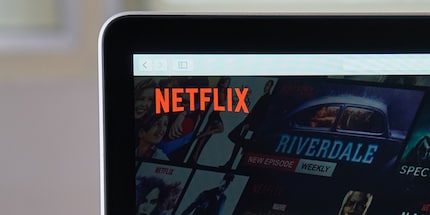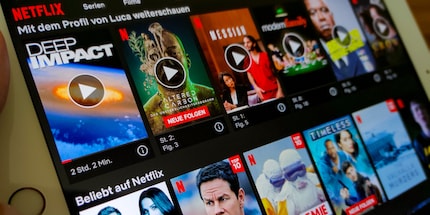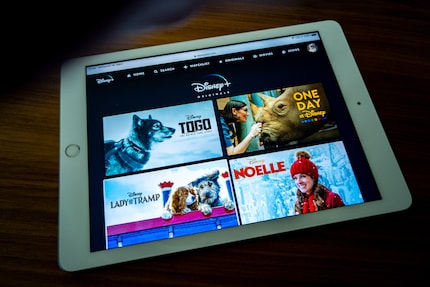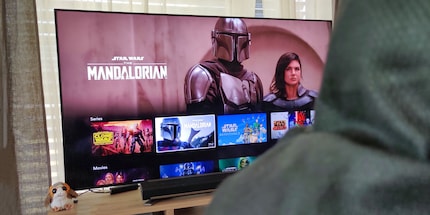
News + Trends
The launch of Disney+: these films and series will be available at the beginning of the year.
by Luca Fontana

Disney+ is being rolled out internationally. Judging by current subscription figures, the service is a blinding success. But whether this will last depends on Disney avoiding Netflix' old mistakes.
If it were up to Disney, the second season of The Mandalorian would already be out now. After all, «The Mandalorian» is a huge success, being praised by critics and fans alike. It's also a big reason for the meteoric rise of Disney+.
Let's look at the numbers: 28.6 million people have subscribed to Disney+ as of February 2 – just three months after its US launch. More recent figures aren't available yet. But they're sure to be higher. The streaming service is being rolled out internationally after all: Disney+ is now available in Switzerland and Germany.
A lucky break for Disney, as CEO Bob Iger had actually expected much lower growth, about 18 million subscribers per year. With that, the first step towards establishing the largest possible customer base has already been taken.
The next step is to retain this base in the long term. Whether or not this will succeed depends on whether Disney can avoid the mistakes of Netflix.
And that doesn't seem likely.
What mistakes? Allow me to explain. Above all, we must look at how the former DVD and video rental company became a titan of streaming.
By the end of 2007, Netflix CEO Reed Hastings saw the end of physical storage media coming before anyone else. That's why he puts all his eggs in one basket: Streaming. For the company, this meant giving up its own video and DVD rental business. Instead, royalties are paid to distribution and production companies to include their films and series in their own streaming library – Disney among a few others.
A gamble. Because in 2007, streaming quality is rather lousy. Worse than DVDs. Nobody was excited about that kind of a service.
But the risk pays off.

Netflix steadily improved its streaming quality and library. Between 2007 and 2010, the newcomer entered into partnerships with Microsoft, Sony and Apple, making its app available on numerous platforms. By the end of 2011, Netflix had over 20 million members.
Scepticism gives way to confidence. Distribution and production companies see Netflix as a new, attractive source of revenue. Precisely because DVD sales are collapsing, claiming prominent victims. One of them being the former distribution giant Blockbuster.
Netflix establishes itself. But its meteoric rise also reveals how much money is hidden in the streaming business and its subscription model – money that distributors and producers also want to get their hands on.
Negotiations on license renewals become more complicated; copyright holders are demanding ever higher fees. Netflix is still in the race. For now. But the radically changing streaming market demands a new strategy: in-house productions.

In 2013, the Los Gatos-based company launches «House of Cards» and «Orange is the New Black». These in-house productions aren't only critically acclaimed, they also prove Netflix' legitimacy as a producer of great TV shows, akin to HBO. Thanks to these in-house productions, laborious license negotiations are no longer necessary. In addition, the exclusivity of these originals attracts new subscribers and convinces them to stay in case other popular series or films come out. A much more enticing offer than ancient films and classic series.
But investing in originals leaves less money for license fees: between 2012 and 2016, Netflix loses about half of its licensed library. Netflix – because of new competition as well – must act. And fast. A new course correction is made: quantity before quality. At least in terms of in-house productions. In other words: the shrinking library is to be topped up with new originals.
Netflix management expresses their goal in numbers: 50 percent of the entire Netflix library should consist of in-house productions. As a result, numerous projects such as «Fuller House», «Frontier» or «Bright» are hurriedly waved through. Logically, they can't keep up with previous productions in terms of both quality and content. In 2016, the Californians invest around 6 billion dollars into their own productions. And this trend only continues: in 2019, this figure reaches 15.3 billion dollars, and by the end of 2028, estimations predict around 28 billion dollars a year. Percentage of in-house productions in October 2018: 37 percent.
Netflix now has 167 million subscribers. Last summer it was 150 million. Subscriber numbers are still going up.
In an article published in July 2019 , business magazine Forbes nevertheless assumes that Netflix's strategy will fail. Although Netflix seems healthy from a global perspective, subscriber growth in the domestic US market in particular has been lower than predicted for years.
In other words, Netflix isn't growing fast enough to sustainably cover the ever-increasing operating costs.
According to Nasdaq, the company has been spending about 2 billion dollars more than it earns every year since 2016. So far, this has had little effect on share prices; confidence in Netflix is high. But if the Californians continue to make less money than they «burn», investors will bail out.
What prevents Netflix from growing faster? In short: mass-producing average-quality content is an ok strategy, but not a great one. In addition, Netflix is one of the most expensive streaming services in the world because of its huge operating costs. As a result, customers exclusively expect high-quality series such as «Stranger Things» or «The Crown», and are quickly disappointed. Competition from HBO, Amazon, Apple, Warner Bros, Sky and Universal doesn't help either.
And Disney+ is headed towards the same brick wall as Netflix.
Disney's starting point is different from Netflix': Disney can avoid expensive royalties thanks to its infamous Disney Bunker already containing most classics. In addition, there are also acquired brands.
There's the Disney and Pixar animated movies for example, perfect for families and children. There's the Marvel and Star Wars films, some of which are among the most financially successful and celebrated films of all time. And National Geographic, as the icing on the cake, offers Oscar-winning documentaries for the curious. All in one place: Disney+.
Disney knows that its backlog – a library of exclusive in-house productions – is secured for the long term; unlike Netflix, it won't shrink due to expiring licenses. This library is also possibly the most attractive one on the market. At least from a Hollywood perspective: Pixar, Marvel or Star Wars – these are powerful brands. There's much less pressure on Disney to constantly disgorge exclusive in-house productions.
In other words: Disney doesn't have a backlog problem like Netflix does.
However, this alone is no guarantee that the current 28.6 million subscribers will stay with Disney. According to a study published in Forbes, but not conducted by the magazine, the two main reasons for terminating a subscription in the USA are:
Therefore, the attractiveness of a streaming service lies mainly in its exclusive in-house productions, not in its backlog. This may sound trite. But it's important. Disney is relying on the appeal of its backlog library. In the long term, however, people don't hold on to a streaming service because of content they already know. They care about new content that needs to be added regularly – in other words, in-house productions. In Disney's case, Disney Originals.
And they're the ones with a problem.
Most Disney originals range from ok to alright in quality. There are a few exceptions. «Togo» for example, a great movie starring Willem Dafoe. Or «The Imagineering Story», one of the best documentaries about Disney there is. «The World According to Jeff Goldblum» is also great. It's a shallow infotainment series, which still radiates a lot of Goldblum charm.

The only thing is, nobody knows about them. And that's a problem. The only Disney original that has been met with similar interest as Netflix' «The Witcher», so far is «The Mandalorian». And judging by how important originals are to subscribers, this isn't enough for a service that relies on the premium reputation of the Disney brand. All the more so because the next Mandalorian season won't appear before October 2020.
The current seventh and final season of «Star Wars: The Clone Wars» will help fill the gap until October. But only among already existing fans of the series. Attracting new subscribers is hard. The next original with similar chances of success as «The Mandalorian» is «Falcon and the Winter Soldier». The series is scheduled for release in August 2020. In five months. The next Marvel production – «WandaVision» – will follow in December 2020. «Loki» won't arrive until Spring 2021.
That's a long while to wait.
In the meantime, Disney+ is content with launching mediocre originals that are nicely produced but garner no interest. «Timmy Failure» for example is boring. The «One Day at Disney» mini-documentaries are exciting, but at 5 minutes per episode they're superficial and way too short. The House of Mouse is also marketing «Stargirl», launched on March 13, as the next big teen romance and coming of age story. The movie doesn't do much aside from sloppily copying similar better movies, however.
This is also evident from a Google Trends analysis: in comparison to «The Mandalorian» and «The Witcher», «Stargirl» arouses a lot of interest on launch day, but quickly falls off a few days later. One week after launch, «Stargirl» is even overtaken by «The Mandalorian» – a series that has been around for months.
So what does Disney have to do better – apart from the obvious, namely to produce better originals?
We have no way of knowing if the Forbes article above, which predicts Netflix's failure, is factual. But we can imagine what purpose an original such as «Stargirl» would have served on Netflix: it would have expanded the library and targeted young adults. Or simply those who are used to browsing the Netflix library and looking at what the Netflix algorithm suggests to suit their own viewing habits.
Because of its backlog problem, Netflix has to produce a lot of new content in a short time. Sometimes at the expense of quality. Something like «Stargirl», for example. But this tactic of «as long as there's something for everyone» can only work for Netflix. After all, that's their strength: anyone can find something they like on Netflix.
But what does Disney+ stand for?
Definitely not diversity. Most likely «family-friendly» content. That's what Disney stands for. But Disney itself doesn't seem to know what that means in the case of Disney+. Recently, «Love, Victor», a teen show about the coming out of a young man named Victor, was moved from Disney+ to Hulu, Disney's streaming service for more adult content. «Love, Victor», obviously isn't family-friendly enough for Disney.
Little games like this one don't help when establishing a new brand. Disney must learn to define itself beyond its own historical name and that of its daughter brands. And soon. What would help is production of quality content. Even better: only quality content. Just like old Netflix did with «House of Cards» and «Orange is the New Black». Just like Disney did with «The Mandalorian» four months ago.
Instead, we get «Stargirl» and «Timmy Failure».

A focus on quality would give people real reasons to keep their Disney+ subscription after watching The Mandalorian. Even if the House of Mouse can't offer the same quantity and diversity as Netflix.
For such a tactic, Disney's starting position couldn't be better. The company can even afford to be patient. There's no urgent backlog problem. Only Disney isn't following this road. What's even worse: Disney, in an attempt to compete with Netflix, is repeating Netflix' decision to favour quantity over quality, which Forbes has at least questioned.
We'll find out more in August with the release of «Falcon and the Winter Soldier».
I write about technology as if it were cinema, and about films as if they were real life. Between bits and blockbusters, I’m after stories that move people, not just generate clicks. And yes – sometimes I listen to film scores louder than I probably should.
Interesting facts about products, behind-the-scenes looks at manufacturers and deep-dives on interesting people.
Show all
Background information
by Luca Fontana

Background information
by Luca Fontana

Background information
by Luca Fontana